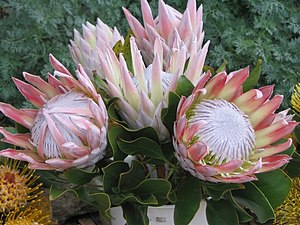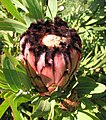Sugar bushes
| Sugar bushes | ||||||||||||
|---|---|---|---|---|---|---|---|---|---|---|---|---|

King Protea ( Protea cynaroides ) |
||||||||||||
| Systematics | ||||||||||||
|
||||||||||||
| Scientific name | ||||||||||||
| Protea | ||||||||||||
| L. |
The plant genus of Protea ( Protea ), and silver trees , Kaprosen or plumes , belongs to the family of proteaceae (Proteaceae). About 115 species belong to it. They come from southern Africa. In Genadendal / South Africa at the Jonaskop (Jonaskopf), at an altitude of 1648 meters, you can find the world's largest number of naturally occurring Protea species. Many of them belong to the Cape flora . The king protea ( Protea cynaroides ) is the coat of arms flower of South Africa .
description

Appearance and leaves
Protea species grow as evergreen, creeping to upright shrubs and small trees that usually reach heights of 1 to 10 meters. The alternate distributed on the branches or at the upper end of the branches standing close together leaves are sessile or pedunculated. The tops and bottoms of the leaves hardly differ. The simple, very leathery, bald to woolly hairy leaf blades are elongated to almost circular. The leaf margin is always smooth.
Inflorescences, flowers and fruits
Many flowers stand close together in characteristic cone-shaped inflorescences with a diameter of 3 to 15 cm. The flowers are wrapped in spirally arranged bracts that overlap in several rows, the outermost being relatively small and gradually increasing in size towards the inside until they are almost the same length or longer than the flowers. The hard, smooth to woolly hairy bracts are sometimes conspicuous, brightly colored. There is always only one flower over a wrapper, not two as in the genera Banksia , Brabejum , Grevillea and Hakea . The inflorescence base is flat to conical.
The flowers are always hermaphroditic. Of the four hairy bracts , three are fused and one is free. There is only one circle with four stamens . The 18 to 33 × 10 to 17 µm large pollen grains are triporate with a mostly slit-shaped aperture. Long, stiff, brown hairs cover the ovary, which contains only one ovule and which merges directly into the smooth or rarely hairy style.
The obscure cone-shaped, woody lock fruit has long, straight, brown, durable hair and contains only one seed.
ecology
Many species form a lignotuber . This is a thickening on the base of the trunk just below or above the ground, from which the plants sprout again after a bush fire . This property is particularly noticeable in Protea roupelliae , which hardly grows in height for the first few years after germination, but also does not grow in width. The small increase in height is caused by strongly compressed internodes .
use
Most species are not frost hardy, they are generally considered not to be easy to cultivate . Central Europeans are familiar with the inflorescences of Protea and some other taxa of the silver tree family (Proteaceae), especially as dried flowers for arrangements , but also as very long-lasting cut flowers that are flown in in winter.
distribution
Of the 115–130 Protea species, around four-fifths occur in southern Africa and around one-fifth in tropical Africa.
Systematics
The genus name Protea was 1771 by Linnaeus in Mantissa Plantarum Altera , pp 187, 328 a second time with the type species Protea cynaroides (L.) L. published. Before that, Carl von Linné had already published the genus name in Species Plantarum , p. 94 in 1753 , but with a species belonging to the genus Leucadendron , and Peter Jonas Bergius in his revision of the group Protea in 1767 made a synonym for Leucadendron . Protea L. 1771 nom. cons. is conserved according to the ICBN rules (Vienna ICBN Art. 14.10 & App. III) compared to the previously published homonym (Vienna ICBN Art. 53) Protea L. 1753 nom. rej. and therefore also preserved compared to Lepidocarpus Adans. nom. rej. Further synonyms for Protea L. 1771 are: Erodendrum Salisb. , Pleuranthe Salisb. ex Knight .
The genus Protea belongs to the subtribe Proteainae from the tribe Proteae in the subfamily of the Proteoideae within the family Proteaceae .
|
||||||||||||||||||||||||||||||||||||||||||||||||||||||||||||||||||||||||||||||||||||||||||||||||||||||||||||||||||
photos
Real sugar bush ( Protea repens )
swell
- Tony Rebelo: Proteas - A field guide to the Proteas of Southern Africa . Fernwood Press, 1995, ISBN 1-874950-02-4 (softcover), ISBN 1-874950-18-0 (hardcover)
- SM Chisumpa, RK Brummitt & S. Marner: Proteaceae. In: GV Pope, RM Polhill, ES Martins (Eds.): Flora Zambesiaca , Volume 9, No. 3, 2006. Royal Botanic Gardens, Kew, ISBN 1-84246-136-2 , (online) . (Section description, distribution and systematics)
- The Protea Project . ( Memento from December 5, 2012 in the web archive archive.today ) (section description)
- The Protea Atlas Project at the South African National Biodiversity Institute = SANBI, Kirstenbosch, Cape Town.
- Anthony G. Rebelo (Ed.): The Protea Atlas of southern Africa - full text PDF.
- Keith Coates Palgrave: Trees of southern Africa . Pages 128–144. 2nd Edition. Struik Publishers, Cape Town, 1988. ISBN 0-86977-081-0
Individual evidence
- ↑ a b c Walter Erhardt , Erich Götz, Nils Bödeker, Siegmund Seybold: The great pikeperch. Encyclopedia of Plant Names. Volume 2. Types and varieties. Eugen Ulmer, Stuttgart (Hohenheim) 2008, ISBN 978-3-8001-5406-7 .
- ↑ Hervé Sauquet & David J. Cantrill: Pollen Diversity and Evolution in Proteoideae (Proteales: Proteaceae) , In: Systematic Botany , Volume 32, Issue 2, 2007, pp. 271-316.
- ↑ Mantissa Plantarum Altera . Lars Salvius: Stockholm 1771 - digitized version.
- ↑ Carl von Linné : Species Plantarum , 1753, p. 94 scanned in at biodiversitylibrary.org .
- ^ Protea in the Germplasm Resources Information Network (GRIN), USDA , ARS , National Genetic Resources Program. National Germplasm Resources Laboratory, Beltsville, Maryland. Retrieved June 11, 2013.
- ^ Protea at Tropicos.org. Missouri Botanical Garden, St. Louis, accessed June 11, 2013.
Web links
further reading
- LM Valente, G. Reeves, J. Schnitzler, IP Mason, MF Fay, TG Rebelo, MW Chase & TG Barraclough: Diversification of the African genus Protea (Proteaceae) in the Cape biodiversity hotspot and beyond: equal rates in different biomes , In : International Journal of Organic Evolution , Volume 64, Issue 3, 2010, pp. 745-760. doi: 10.1111 / j.1558-5646.2009.00856.x
- JE Carlson & KE Holsinger: Developmental Plasticity in Protea as an Evolutionary Response to Environmental Clines in the Cape Floristic Region , In: PLoS ONE 7, 12, 2012. doi: 10.1371 / journal.pone.0052035











